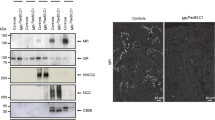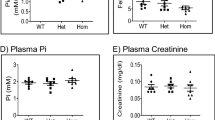Abstract
The mineralocorticoid receptor knock-out mouse (MR–/–), resembling inborn pseudohypoaldosteronism, dies 8–12 days after birth in circulatory failure with all the signs of terminal volume contraction. The present study aimed to examine the functional defects in the kidney and colon in detail and to attempt to rescue these mice. In neonatal (nn) MR–/– the amiloride-sensitive short-circuit current in the colon was reduced to approximately one-third compared to controls (MR+/+ and MR+/–). In isolated in vitro perfused collecting ducts the amiloride-induced hyperpolarization of the basolateral membrane (V bl) of nn MR–/– was similar to that of controls, but urinary Na+ excretion was markedly increased to 4.3 µmol/day·g (BW). Based on this measured urinary Na+ loss we tried to rescue nn MR–/– mice by injecting NaCl twice daily (3.85 µmol/g BW), corresponding to 22 µl of isotonic saline/g BW subcutaneously. This regimen was continued until the animals had reached a body mass of 8.5 g. Thereafter, in addition to normal chow and tap water, NaCl drinking water (333 mmol/l) and pellets soaked in 333 mmol/l NaCl were offered. Unlike the untreated nn MR–/– most of these mice survived. The adult animals were examined between days 27 and 41, some were used for breeding. When compared to age-matched controls the growth of MR–/– was delayed until day 20. Then their growth curve increased in slope and reached that of controls. MR–/– retained their Na+-losing defect. Amiloride’s effect on urinary Na+ excretion was not significant in MR–/– mice and the effect on V bl in isolated cortical collecting ducts was attenuated. The renin-producing cells were hypertrophic and hyperplastic. Plasma renin and aldosterone concentrations were significantly elevated in MR–/– mice. These data indicate that MR–/– can be rescued by timely and matched NaCl substitutions. This enables the animals to develop through a critical phase of life, after which they adapt their oral salt and water intake to match the elevated excretion rate; however, the renal salt-losing defect persists.
Similar content being viewed by others
Author information
Authors and Affiliations
Additional information
Received: 22 February 1999 / Received after revision and accepted: 29 March 1999
Rights and permissions
About this article
Cite this article
Bleich, M., Warth, R., Schmidt-Hieber, M. et al. Rescue of the mineralocorticoid receptor knock-out mouse. Pflügers Arch 438, 245–254 (1999). https://doi.org/10.1007/s004240050906
Issue Date:
DOI: https://doi.org/10.1007/s004240050906




